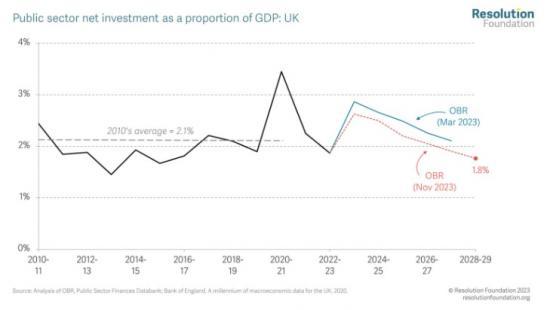Cutting Back On The Investment And Delivery Of Public Services Is Not What The Economy Needs - Or What The Electorate Wants
28th February 2024

The Government's current plans for post-election cuts to public spending look undeliverable given rising prices and increasing demand on services. As discussed below, plans to cap day-to-day spending increases at 1 per cent (after allowing for inflation) imply very big cuts to departments not covered by existing spending commitments. This is particularly worrying given pre-existing chronic underfunding in recent year which has led to crumbling public services.
Planned public-spending cuts will hit unprotected departments hard
When combined with projections for health, defence and education real day-to-day spending growth of 1 per cent between 2025-26 and 2028-29 imply cuts to unprotected departments' - such as justice and local government - real per-capita day-to-day spending of 18 per cent from the recent peak in 2022-23 by 2028-29.
Cuts on this scale would be comparable to the experience of ‘austerity' years, but starting from a position in which many public services are in a dire state. Falls of 18 per cent in real per-capita day-to-day spending over six years is equivalent to two-thirds of the cuts made on this measure from 2010-11 to 2016-17 at the height of austerity.
But choosing higher spending limits does not seem to be the Government's priority
Choosing to deliver improvements to public services comes with significant financial costs. Returning unprotected departments to 2022-23 levels - which, as already mentioned, would still be substantially below levels seen before austerity - would require an extra £30 billion of spending. The Government has been clear that it wants to prioritise cutting personal taxes ahead of an election this year, rather than raising spending plans in the medium term.
The Government is even rumoured to be considering cutting growth in real, day-to-day spending from 1 per cent to 0.75 per cent to make further room to cut taxes. This would increase the cost of returning unprotected departments to 2022-23 levels by an extra £5 billion, in the face of budgets being slashed by a fifth.
Tax cuts would also come at the cost of growth-sapping cuts to public investment
Investing too little for one year is manageable, but doing so year after year is a recipe for relative decline. Public investment in the UK has remained consistently low for decades, at around about half the average of OECD advanced economies, and is a key reason behind why productivity in the UK lags behind that in peer countries such as France and Germany.
Alongside planning cuts to unprotected departmental budgets, public investment plans consistent with last November's Autumn Statement showed that capital spending a share of GDP is also set to decline by around a third between 2023-24 and 2028-29, equivalent to a £20 billion annual reduction in investment.
The failure to provide consistent funding for transport, housing, healthcare and local services has clear consequences for our day-to-day lives. The UK has fewer hospital beds per person than all bar one OECD advanced country, and we spend more time commuting than all bar two.
Read the full article from The Resolution foundation HERE
